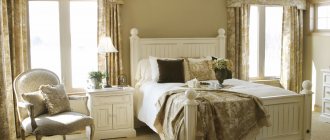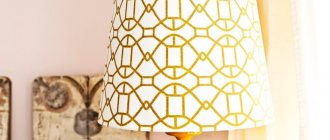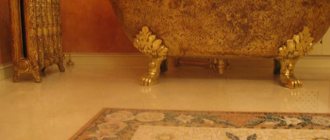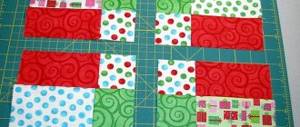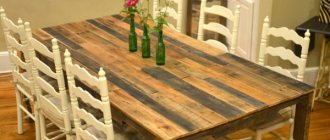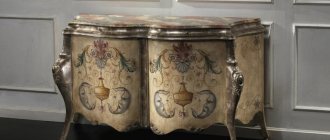Furniture in the Provence style is not difficult to create with your own hands. Recently, furniture made by yourself has been gaining popularity. This trend has not bypassed such a style as Provence. Therefore, if there is no store anywhere in the area where you can order such furniture, then you can easily make it yourself. In this style, it is important to take into account many nuances and useful recommendations.
A style called “Provence” appeared in France in the 19th century. It was named after one of the regions of this country. The capital of the style was the city of Marseille.
The prerequisites for Provence appeared in the mid-17th century. People wanted to get closer to the village from the boring bustle of the city. Entire families of industrialists and lawyers begin to furnish their own homes in a style reminiscent of this style.
The Provence style, widespread throughout the world, has French roots.
The main features of the style were:
- game of sunny colors,
- natural lightness,
- naturalness,
- open space.
Stylistic decisions
- Solid floor
. The classic version involves the presence of wooden or. Using special floor tiles you can easily achieve this effect. - Walls
. Wallpaper in the generally known sense does not exist in this style. In this case, brickwork or carelessly applied plaster are most suitable for this design. - Furniture
should ideally create a feeling of antiquity. Make it with your own hands so that guests have the impression that it has been passed down to each other for many generations. - Details.
Any, even the smallest details must be carefully thought out and planned. In this style, even the most ordinary napkin can carry a certain semantic meaning.
Secrets of Provence style (video)
Several ways to age furniture surfaces
Artificially aged furniture looks as excellent as truly antique furniture. However, it is much easier, faster and cheaper to do.
Of the ways in which you can age furniture yourself at home, there are three main ones:
- Mechanical
. Thanks to this method, artificial scratches, cracks and other damage appear on furniture. - Chemical
. In this embodiment, substances such as craquelure varnishes, ammonia, stain and much more are used. - Thermal
. Using an open fire or a soldering iron, an antique effect is achieved.
Necessary tools and materials for making furniture in Provence style
For professional furniture restoration you will need
:
- acrylic paint,
- matte polyurethane glaze,
- oil and water based varnish,
- gold effect paint,
- sandpaper,
- necessary stencils.
Decoupage is an integral part of creating the Provence style with your own hands
Artificially aged furniture surfaces are a clear sign of Provence style
Provence style may not necessarily be made in cream or white
Do-it-yourself stages
All work happens this way:
- All fittings are dismantled and cleaned of old paint and varnish.
- Acrylic paint is applied to the surface.
- Using a stencil, you make a drawing with your own hands, which must be left alone until completely dry.
- Oil varnish is applied to the surface and left for several hours.
- After this, the product is coated with a layer of water-based varnish.
- Using a hair dryer, the effect of a specific flowing pattern is created. The product is left in this position for 3 hours.
- Using a hard small brush, apply the remaining varnish to the product.
Using eggshells and craquelure varnish, an artificially aged surface is created
The main touches that give the surface individuality are best applied without a stencil.
Upholstered furniture and its upholstery
Using a furniture stapler, you can thoroughly transform upholstered furniture. First of all, you need to choose a fabric.
It must be:
- soft,
- having a pattern with natural elements or geometric shapes,
- no flashy colors.
Finding such fabric is not difficult. All you have to do is climb into your grandmother's chest or attic.
In addition to the method described above, there is another way to give the furniture an antique effect. An interesting technique that uses two-component crackle varnish will help in this matter. It is applied in several layers. Using a brush with natural bristles, apply the layers in an even, thin layer. The varnish dries in 40 minutes.
The second layer is applied in the same way. The more cracks you want, the thicker the layer itself should be. To make the surface dry faster, you can dry it with a hairdryer. When the varnish dries, all resulting cracks are rubbed with dark oil paint, gold powder or bitumen. To consolidate the effect, another layer is applied with colorless varnish.
Upholstery of upholstered furniture in the kitchen can be combined with wall decoration in the same style
Furniture in Provence style
When choosing furniture in this style, you must remember that Provence is the embodiment of nationality and closeness to nature. Therefore, only natural materials can be used in the manufacture of furniture. These cannot be serial sets: all furniture elements are carefully selected or made to order. The trend is old things inherited from previous generations.
Characteristics
All pieces of furniture in the Provence style have simple shapes, without excessive luxury and obtrusive decorations. Numerous chests of drawers, cupboards with transparent or solid doors, open shelves, and chairs with carved legs look good. Forging can be used for decoration, for example, handles on furniture, headboards of a bed. To paint furniture gables, darker paints are used than for walls. Lacquered natural wood always looks good - light walnut, oak, chestnut.
Interior decoration in Provence style
Provence style decor
How to make furniture in Provence style with your own hands
It is not necessary to make custom-made furniture for a new interior - it is very expensive, and besides, almost everyone has pieces of furniture inherited from previous owners. You shouldn’t throw them away – just a little work is enough to give the furniture a new life with your own hands:
- all pieces of furniture are cleaned of old paint;
sand their surface with sandpaper;
the next stage is to paint the furniture black or deep shades of gray and brown;
after the first layer has dried, all furniture elements are painted again - white or shades of the selected pastel color;
after waiting for the paint to dry, carefully pass sandpaper over the protruding parts of the painted furniture, creating the effect of slight abrasion and aging;
The work is completed by polishing the surfaces with a soft rag with the addition of wax.
This type of finishing will help make even new furniture look old. You can achieve the desired effect by giving the surfaces a slightly worn look, imitating chips or traces of wormholes.
To combine different pieces of furniture in a Mediterranean interior, you can not only paint them the same and then age them. An even greater effect can be achieved using the decoupage technique for furniture, which is very welcome in the Provence style. Designers advise decorating the pediments of furniture with stylish designs using ordinary napkins, glue and a brush. After the drawing has dried, do not forget to cover the surfaces with a layer of protective varnish.
Interior decor in Provence style
Design decoration idea in Provence style
Modern decor in Provence style
DIY chest of drawers and its decoupage
Provence style furniture is made from:
- wood,
- gland,
- vines
Designers categorically do not recommend using materials such as chipboard, MDF and PVC.
If you still have your grandmother's chest of drawers, then you can make it as good as new and even better. It’s enough to do some easy decoupage with your own hands.
The manufacturing instructions are as follows:
- First you need to paint the chest of drawers in light colors.
- Wait for the paint to dry completely.
- Using sandpaper, chips and simple abrasions are made on the surface.
- The top of the chest of drawers is covered with wax.
- When the paint is completely dry, the chest of drawers is upholstered in soft fabric depicting natural patterns.
- It is also important to use forged elements. The chest of drawers will look much better if it has forged arms or legs.
You can create a unique design of any furniture with your own hands
Provence style does not have to include scuffs
In general, a chest of drawers is not the only piece of furniture to which decoupage can be applied. The main thing is to use materials and colors correctly to achieve coziness and comfort in any room.
Of course, you can buy a new high-quality chest of drawers at a hardware store. But many people are faced with the fact that this piece of furniture is expensive and many simply cannot afford it. That’s why decoupage in Provence style is simply an amazing solution to this problem.
Product Features
As already mentioned, exclusively natural materials are used to produce doors in this style.
Budget options are made using MDF.
Finished products include natural motifs, small windows, floral patterns and a small number of straight lines.
Each door, decorated in Provence style, has its own characteristics.
Common ones include:
- Traditional form;
- Complete exclusion of various additional materials and inserts. The only exceptions can be models with small windows containing mosaic glass.
- Having a calm color palette. The predominant shades are white, gray and beige tones. The most important condition in coloring is the use of warm and cheerful colors: delicate lilac, peach, lemon, pale blue. All these colors represent the landscapes of France.
- A minimal number of protrusions are used here. The main decorations can be a panel or a frame.
- There must be symmetry in individual elements.
- The use of gloss is unacceptable. Provence is characterized by the fact that it emphasizes the woody structure.
- Metal elements cannot be used. This point does not apply to hinges and door handles with locks.
Doors designed in this style can be either new or old after restoration. Today, specialists are increasingly using artificial aging. Thus, you can get a unique, charming and original product.
Furniture design in Provence style (photo)
Provence style is a fashionable hobby that has fans both among avid needlewomen and among people who have never previously picked up knitting needles or a brush. While psychologists are wondering whether this is due to the desire to be distracted at home from the frantic pace of megacities or with distrust of the modification products that have filled everything, designers suggest dragging, re-gluing, changing and transforming. The trend, which has become trendy in recent years, is simple and accessible if, in addition to theoretical familiarization with the concept, you also engage in the practical implementation of ideas. A bonus for patience and diligence will be pleasure from the process and the result. So, the WESTWING shopping club invites you on a tour of the French countryside.
DIY design ideas in Provence style (photo)
What should furniture be like in Provence style?
Household items made in this style are distinguished by a certain lightness and laconicism, reflected in the color scheme. It is dominated by white color, baked milk and lavender. Provence was close to nature and simplicity, so all the interior elements belonging to it were made of natural materials: wood, stone, fabric. As it is commonly defined today, this is eco-style. It is also reflected in the equipment of the room, in the interior items: simple, rather old tables, chairs, cabinets, wrought iron beds, napkins and linen tablecloths - everything creates a unity of design.
Furniture in the Provence style with your own hands, in addition to its main functionality, also plays a decorative role. She must be:
- old or aged, with scuffs, chips or traces of wormholes that appear after prolonged use of the furniture;
- necessarily - painted with light paint that has lost its shine;
- made from natural wood: walnut, oak or chestnut.
DIY antique wooden kitchen cabinet
As for the color scheme, the style requires delicate, pale, somewhat faded shades:
- white and milky;
- beige;
- olive green;
- lavender or sea colors,
- ocher, terracotta.
Pastel shades for a bathroom in Provence style
As strange as it may seem, an old cabinet with peeling paint is the most trendy element when decorating a room in this style.
Chic, spacious wardrobe for a bedroom in Provence style
Provençal chic in the interior: the origins of French impeccability
Why exactly the southern French province received the honor of giving the name to the entire direction, no one will remember. Rural motifs, characteristic of the entire suburb, became so fashionable in the mid-19th century that even blue-blooded people willingly posed for portraits as innocent shepherdesses. The azure of blooming lavender, the snow-white gloss of robes, lace and greenery - for the spoiled and rather depraved French court, such themes became the height of grace and a sign of good taste.
Pastoral pictures and tapestries with provincial motifs became an integral attribute of royal boudoirs and bedrooms. Since that time, little has changed: the rural style also relies on natural colors, deliberately rough furniture and floral motifs
. This allows you to independently build a fashionable interior: furniture decor in the Provence style does not require expensive fittings or luxurious fabrics, it is democratic and affordable.
We embody the Provence style in the interior with our own hands
Furniture selection
The highlight of a bedroom in the Provence style is the feeling of antiquity. When you enter such a room, it seems that you are no longer the first owner of this room. Depending on the area, the interior may consist of a bed, chairs, ottomans, shelving and bookshelves. It is important to observe moderation and not to overload the room with unnecessary items. It is important that all furniture is made of wood or painted.
The main detail of the bedroom is the bed. She should be given special attention, since she must meet the requirements of both spouses. Provence is considered a more girly interior, so when choosing a bed, you should take a closer look at carved, massive models made of natural wood. Bedding should be made from natural fabrics with minimal print.
A vintage bookcase or antique chest of drawers will fit perfectly into the interior and become additional storage space. It is not necessary to purchase such furniture in a store; you can take a closer look at antique items in the country. After proper restoration and replacement of fittings, they will become an integral part of the bedroom.
A dressing table or dressing table with carved legs will make the owner of the room feel like a princess and fill the room with romance.
Antique furniture can give a feeling of calm and noble chic, as if returning its owner several centuries ago.
Mandatory requirements for interior design in Provence style
The first and main condition for interior design in the Provence style is naturalness. The flooring should be wooden or stylized as solid wood, natural curtains and tapestries, decorated with embroidery or a careful imitation of it. Furniture that is appropriate is exclusively wooden, a little awkward and rough. The best option: polished even without the use of glossy varnish or painted in a background white color, and then decorated with naive pictures using the decoupage technique. If you do not take into account the characteristic color scheme, then Provence is not much different from the country style of any other country
: bleached linen, embroidery, elementary painting of dishes, handmade rugs and numerous thought pillows. The soul of the author can be felt in any of the interior details. There is no place for stamping and flow production in this comfort.
Wall decoration
When decorating a bedroom in Provence style, natural materials are used for finishing in pastel colors. Suitable wallpaper colors are:
- pistachio;
- lactic;
- blue;
- beige;
- soft lilac;
- terracotta.
The texture can be stylized as a plaster coating, have a floral pattern or a cage. Geometric patterns on a light background can look advantageous with the right selection of furniture and decor.
Traditional style involves the use of natural materials for wall decoration, which include brick, rough boards, and plaster. To achieve the closest possible effect, you can combine the wallpaper at the head of the bed with one of the listed materials.
Wallpaper with small roses adds romanticism to the bedroom.
Wallpapers with birds make us closer to forest nature.
Large buds on the walls accentuate the look.
Tired of the sun: characteristic colors of the Provence style
The color scheme of the Provençal interior is defined by designers as pastel with bright accents. Mostly these are shades of blue and lilac, symbolizing sea waves and blooming lavender. Slightly less common are sandy yellow and bleached terracotta. This is a tribute to the sandy beaches and hundred-year-old forests. Greenery is required, but it does not scream, but only modestly reminds of itself with the shades of foliage scorched by the hot sun. All this fits into the white motif that runs through the entire idea. Selecting colors to reupholster or paint pieces of furniture is not difficult: this is one single color added to white in different concentrations. One could call this color scheme boring if it weren’t for the color “highlights”:
- juicy lilac thoughts carelessly thrown on top of a rough linen bedspread;
- bright peonies in a simple clay vase;
- a spectacular additional curtain, slightly released from under the thick curtain;
- knitted bedside rug.
The patterns of southern France are unobtrusive and unpretentious: stripes, small floral motifs, lace and blurry checks. At the same time, the elements do not overload the overall background, but only slightly emphasize it.
Techniques for effectively transforming furniture with your own hands
Grandma's chest of drawers and floor lamp with a long-burnt lampshade - do they seem like they should go to the landfill? Nothing of the kind, their time has just come. The first will need to change the cracked varnish to a shiny white paint, the second will need to update the gloss and reupholster. Moreover, you don’t even need to buy expensive fabric to update the lampshade: a vintage tablecloth with printed or embroidered flowers along the border, taken from the bottom drawer of the same chest of drawers, will get a second life. The remains of the same tablecloth can be made into chair covers, which will eliminate the need to replace previously purchased modern models with artificially aged samples. The table is covered with a napkin made of coarse linen, and a plain blanket with a lace insert is thrown over the sofa.
Aging to renew: restoration of Provence furniture
Buying artificially aged furniture is not difficult: the supply generated by demand has suggested a profitable niche to manufacturers. There is another option, thanks to the advice of experts from the WESTWING shopping club, existing furniture is transformed: Provence is accessible even to a novice designer.
Wooden furniture primarily requires improvement.
. Old varnish or paint is removed from it with sandpaper, after which the surface is thoroughly degreased. The abundance of tinting varnishes on sale solves the problem of color selection. The provincial atmosphere is characterized by slightly reddish tones of wood: rowan, oak, apple tree. They will go well with red petals, which are popular in floral motifs. This kind of aging of Provence furniture will only take a couple of days, since with good ventilation the varnish dries in a matter of hours.
Painting furniture is no more labor-intensive process, but the color needs to be mixed for all prepared surfaces in advance, because even experienced craftsmen rarely manage to get a perfectly identical tone a second time. In extreme cases, the mixed paint should be enough to cover all external surfaces; for internal surfaces, slight discrepancy is not critical. Decoupage of furniture or simple stencil painting will be the most appropriate decoration.
Psychologists say that Provence in the interior is not only fashionable, but also useful. Soothing, gentle tones have a positive effect on sleep quality and reduce anxiety. A romantic setting promotes the expression of the most tender feelings. Provencal style - a corner of France in your own apartment.
How sometimes you want to give your home a new touch, update the furniture and the overall interior. How you want to plunge into the spaciousness and comfort of a bright living room, feel the delicious notes of lavender and feel the sea breeze. But unfortunately, not everyone can afford a radical change of style. Is this your case? Then DIY Provence furniture is your option!
Origin of Provence style
Provence style originates from France. Just as in Russia there are wide expanses of golden fields - with wheat, oats, rye, so in Provence you cannot take in the endless fields of lavender with your gaze. Golden sands of the beaches, blue and as warm as fresh milk, sea, lavender bushes - this is what characterizes this area.
Also in the interior - a distinctive feature of furniture in the Provence style is the spaciousness and softness of colors ranging from milky to rich, but soft lavender. When trying to recreate the outlines of the French countryside in your home, pay attention to the lightness, laconic forms, but at the same time tenderness of the furniture. In the Provence style, artificially aged interior items that seem to have been bleached by the sun are used.
Provence, as it is fashionable to say now, is an eco-style, it is characterized by natural materials such as stone, wood, cotton. Another name for the style - French country - is also sometimes used in everyday life.
Color range of doors in Provence style
Despite its venerable age, the Provence style still pleases its modern fans with the simplicity, grace and harmony of a serene rural life. The absence of overloaded interior details creates a feeling of cleanliness and comfort. And the soft color scheme, as if slightly bleached by the sun, calms and relaxes the body. By the way, the correctly chosen shade determines by 80% whether the door belongs to this direction.
When choosing the color of doors in the Provence style, they rely on the principle of complementation, not contrast. For example, there is no need to wedge bright spots in the form of doors of a contrasting color into a carefully planned pastel space. On the contrary, their color should continue the feeling of peace and relaxation created by the designer.
Choosing the color of doors in Provence style
Despite the fact that the color range of the Provence style is limited to calm pastel shades, door colors can be chosen to suit every taste. Among them there are both pure white and wood-like colors, for example, oak, American walnut.
The most common colors of interior doors in the Provence style are as follows:
- white (not snow-white, but closer to vanilla or ivory);
- lactic;
- pastel yellow;
- blue and blue-gray;
- lavender;
- cornflower;
- ash pink;
- terracotta;
- soft green;
- chocolate.
White doors in Provence style photo
No matter how hard manufacturers try to diversify the color range of Provence-style doors, white doors are the constant sales leader. And so that plain designs do not look bland, they can be decorated with paneled inserts, carvings, paintings and other methods, which we will consider later.
In this video, watch how to convert an ordinary door into Provence.
Distinctive features of French country in the interior
So, you decided to recreate a small piece of the French village in your apartment. Let's see what stylistic decisions are applicable in this case:
- Walls. For the Provence style there is no wallpaper in the broad sense of the word, but we are not talking about wallpaper that is minimally structured. That is, if the wallpaper is simply laconic and has calm tones, you can safely use it in your interior. The Provence style is characterized by sloppily applied plaster, brickwork and simple wall coverings.
- Ceilings. Characteristic ceilings in the Provence style are beamed ceilings, or simply painted white.
- Color solution. Try combining the lightness of pastel colors with richness. If you are not satisfied with white walls, or you have associations with a medical facility, pay attention to milky, olive or warm gray tones.
- "Massive" floor. Classic Provence assumes the presence of a stone or wooden floor. Nowadays, this can be achieved with terracotta floor tiles or laminate flooring in a faded wood color.
- When creating furniture in the Provence style with your own hands, note that it should evoke a feeling of antiquity, as if it had been passed down from generation to generation.
- Think through all the details carefully. Let each linen napkin, each plant or figurine carry its own meaning.
It’s not so difficult to recreate the Provence style with your own hands, the main thing is to close your eyes and imagine yourself in the village. What do we see? Old wooden furniture, wrought iron beds, linen napkins. Add a little modernity and romance to this; wicker chairs, ornateness and at the same time simplicity of wooden chair backs will fit perfectly.
Designer white doors Provence
The direction of this style originates from the architecture, interior and nature that the French province represents.
Provence is associated with blue skies, sea waves, endless fields, fragrant lavender, lush grass and warm sun.
Interior doors designed in this direction are very easy to recognize, as they contain certain design elements.
For example:
- Decoration in white. This solution is traditional, since this color in combination with pastel shades creates the basis of Provence. White door leaves can be decorated with interesting carvings; decoupage can be used. Vintage elements that bring antiquity and comfort to the atmosphere are very popular.
- Presence of painting. This makes it possible to completely change the appearance of the door leaf and at the same time it becomes very attractive. A suitable design could be a bouquet of lavender, a Mediterranean scenic view, or an olive branch. If the design is purchased to order, this detail can be discussed with the master and express your wishes. Today, specialists can not only age a new door, but also add elements to it that will blend harmoniously with your interior.
- Using dark oak. This decision is new and quite bold. The wood has a pleasant structure and does not require additional processing. The model with glass is painted in light colors. Models that include geometric decorative shapes look interesting.
Today, consumers increasingly prefer sliding doors designed in Provence style. They are easy to use and include ergonomic handles. In addition, they save a lot of space.
Rules for furniture styling
You are attracted by the comfort, lightness and romanticism of style, and you decided that it’s time to find a use for your hands and dream up a little, but first, familiarize yourself with the basic rules of furniture style.
- Don't try to create a modern dresser or nightstand. There should be no modernity, only “grandmother’s” carved facades and severity of forms.
- There should be no glossy surfaces! On the contrary, try to create artificial chips and cracks. Some manage to imitate damage to furniture by bark beetles.
- All wooden surfaces should be repainted in soft, light and necessarily compatible colors.
- Wicker furniture will add lightness and comfort to your interior. For example, you can use wicker chairs or an armchair. By the way, you can create wicker items yourself using wicker or rattan.
- The French country style is characterized by the presence of forged elements. If you have the necessary skills, you can create forged shelves, hooks, stands or legs for furniture. If not, you can do it easier, for example, make an ornate vase stand with your own hands using ordinary aluminum or copper wire. Just don’t leave the job halfway; you will need to paint it, for example, white and carefully use sandpaper with the finest granulation to clean the edges of the product to create an antiquity.
- Provence style cabinets are quite massive and tall, but with carved fronts that add grace to the shapes. Chests of drawers and nightstands most often have either curved wooden legs or fancy wrought iron ones. In the old days, chests of drawers and cabinets were locked. You can also decorate them with non-functional keyholes.
- Remember that the style of an apartment is a combination of the styles of each room. And the style of a room is a set of styles of objects that combine with each other. Therefore, when recreating the uniqueness of France, pay attention to small details; you can also decorate photo frames, or, for example, vases.
So, you have decided to breathe some color into your home by changing the furniture and making renovations. A budget option would be to make furniture yourself, or give new life to old interior items.
Decorating an old chair in Provence style
Before you start work, you need to acquire the necessary materials:
- The chair itself.
- Thick upholstery fabric in the color of the interior (if you want to highlight and make a bright accent, pay attention to lavender or blue shades, and if the accent is already on something else, choose upholstery to match the color of the walls or floor).
- Acrylic paint of the desired shade (cream, white, ivory).
- Brushes of various diameters.
- Matt varnish. Choose water-based varnishes; they won’t have a pungent odor and you won’t have to sit by an open window for hours waiting for the room to air out.
- Paint with gilding effect.
- Sandpaper.
When starting to reconstruct a chair, first take care of a comfortable working space. Found it? Let's get started!
- The first step is to remove the old paint from the chair. This can be done using a knife or spatula. If the chair is varnished, and you can even tear the paint off it with your teeth, leave everything in place, don’t suffer.
- The next step is to remove the upholstery from the chair. Usually on old chairs the seat itself can be removed just fine, try it. Assess the scale of the disaster - is it worth changing the seat pad? If you still have to, then you will need to get furniture foam rubber.
- If you are unable to remove the chair cover, try applying paint to a small area. Evaluate whether it fits well. If there are no problems, start covering the entire chair; if there are problems, wait until the layer dries and apply another one on top. Assess the condition of the paint now. If you were unsuccessful again, I hasten to disappoint you - you will still have to remove the coating by sanding the coarse granules with sandpaper.
- After applying two layers of paint, wait until it dries completely and varnish the product. Let's move on to the seat. Remove the upholstery and carefully, with a thin brush, paint the wooden parts of the chair. Next, stretch the new upholstery; you can easily secure it with a construction stapler.
- You're almost done! Secure the seat on the chair with the help of a man. Now you can resort to aging. Use a flat brush to paint all edges with gold paint. Wait for it to dry and use fine-grained sandpaper to carefully sand down the gold fragments. Coat the top with varnish again. Congratulations to you! One piece of furniture is ready!
- It is worth saying that you can not only repaint old interior items, you can decorate them with various ornaments. If you know how to draw, this will not be difficult for you to do. If not, learn the decoupage technique and use it using ready-made cuttings.
Making furniture yourself
So, you have decided to make your own furniture. First, decide what exactly you want to create? Will it be a cabinet, chest of drawers, or maybe a stool? Secondly, decide on the choice of material. Provence does not tolerate materials such as chipboard, PVC, MDF. Furniture made from these materials will definitely not be from that song.
We will not describe what is needed when making furniture. Let us describe the most important stylistic components that will distinguish it from any other style.
- Carved components. It is quite difficult to carve facades, and if you are unable to do this, simply use carved legs, handles, or sides.
- You can drive a couple of decorative nails into the ends; they will emphasize the feigned heaviness and antiquity of your product.
- Use decorative elements - this can be modeling, but carefully disguised with wood paint.
- Come up with a stencil; if it doesn’t work out, you can find it on the Internet. Use it to add personality to your furniture. You can use it, for example, on the sides of a chest of drawers. You can make an interesting move - let the furniture be light, and let the ornament match the color of your bright accent. Or you can do it differently: make both the ornament and the furniture light, but the difference in a couple of tones will look gentle and impressive.
- Naturally age the furniture, rub sandpaper along the edges, you can use the gilding method described above, in general, do whatever your imagination is capable of!
- Use heavy brass accessories such as handles. Remember that they need to be fastened at the very last stage, when the furniture is ready to take its rightful place in the room.
This is how you can easily and simply create a French province from your home, breathe into it the romance of the sounds of an accordion and the fresh smell of lavender steppes. Feel free to experiment and make new changes to your interior. You may have to try hard to recreate it at first, but your efforts will be rightfully rewarded with admiring exclamations from the guests and your family feeling the comfort of a family nest. Be creative, don’t be afraid to experiment, and everything will work out!
And interior items in the Provence style are a fashion trend today. Perhaps someone would like to decorate their home with an interesting detail in this style. In order to acquire such an interesting thing, it is not at all necessary to go to a special store. And such unique items are not cheap. The fashionable passion for Provence did not pass me by, and I decided to make a shelf myself.
So, in order to get started, you will need: a small piece of plywood 4, 6 or 8 mm thick, several wooden slats 1 cm thick, small nails (or wood glue), acrylic paints and varnish for decoration, and a hand jigsaw for cutting out parts .
First you need to decide on the size of the product. My shelf will have dimensions of 38 cm by 22 cm. Having made the appropriate marks on the plywood and slats, I carefully cut out the necessary parts with a jigsaw. The end result was a set of four side pieces, one interior shelf piece, and one main plywood piece. I fastened the parts with nails. You can use glue or self-tapping screws. The base of my product will be figured, so the corresponding markings are made on the plywood base using a compass. Then I sanded the piece with fine sandpaper. The wooden blank is ready.
Now you can begin the most creative and exciting part of the process - decorating. I decided to decorate it in a slightly unusual color scheme for this style - gray and white. Through trial and error, I determined that it was the light gray shade applied to a wooden base that, when artificially aged, gave an interesting effect. And in order to give my shelf some personality, I applied the design using a homemade stencil made of thick paper. You can give the product the appearance of a well-worn item by lightly sanding some parts with fine sandpaper. That's what I did.
Every residential property owner wants every room in his house or apartment to be attractive, interesting and unique. For this, it is considered optimal to use various techniques that are implemented on your own and contribute to the unusual design of any piece of furniture. Decoupage of furniture in the Provence style is considered an excellent solution. The master class will give you the opportunity to master the technique. By doing the decorating process yourself, you won’t need to spend a lot of money to get bright and sophisticated interior items.
Creating a Provence style involves artificially aging various furniture surfaces. Decoupage is a unique technique that allows you to get vintage items. A video lesson of this process is located at the end of the article.
Decoupage can be performed in different ways, involving the use of a variety of paints and the use of various textile or paper patterns.
The decoupage method, which involves the use of a special crackle varnish, is becoming popular. It is applied to different surfaces in a fairly significant layer, and often several layers are used at once. As it dries, numerous cracks appear on the surfaces of the piece of furniture, and they are quite interesting and unusual, so this solution fits perfectly into the Provence style. After drying, it is recommended to cover the surfaces with paints of suitable colors, and the decoupage is secured with transparent varnish.
Other popular techniques for aging furniture that are easy to implement with your own hands include:
- mechanical influences involve the use of various tools, with the help of which various cuts, cracks or scratches appear on the surfaces of furniture, and they do not need to be applied in a chaotic manner, since the optimal pattern must first be made to obtain an excellent result;
- chemical influences involve the use of various chemicals on the surface of furniture, and the most popular for this are vinegar and ammonia, which ensure a change in the appearance of different products;
- thermal methods involve the use of high temperature or open fire, and a special blowtorch is often used, but when using this method with your own hands, you should be especially careful not to cause significant damage to yourself, and also study the training video first;
- the use of numerous special liquid products, and they can be applied with brushes, rollers, a spray gun or other tools, and their choice depends on what kind of result is to be obtained.
Decoupage is considered the most popular way to change the appearance of any interior item. It involves the use of exquisite and unique ornaments. To implement the process yourself, you should prepare different images on paper or textiles in advance. Surface preparation depends on what material the furniture is made of.
DIY furniture decoupage
Decoupage of cabinets in the Provence style involves the same set of preparatory work as for stencil painting. As a motive for the design, you will need several napkins, fabric, postcards or book/magazine pictures with a floral print. Or purchase a special blank for decoupage.
The simplest material for self-use is a napkin. When working with it, it is enough to separate the top layer of paper covered with a pattern. Other materials will require pre-soaking to allow the image to peel off. If the bottom layers are not separated, the end result will be sloppy and require a lot of varnish to even it out.
In addition, you will need a standard set of tools and materials:
- decoupage glue (special mixture or diluted PVA);
- tweezers;
- several brushes;
- thin, well-sharpened scissors;
- acrylic varnish for fixing.
Direct decoupage begins with applying glue to the surface to be transformed. The glue is applied in a thin layer using a brush.
Then, using tweezers so as not to tear the material, the cut out fragment of the design is pryed off. The material is applied to the selected point on the surface and leveled with careful movements of a dry brush.
You need to make sure that there are no air bubbles left under the picture, and that the picture itself does not have folds. After this, excess glue is removed from the surface, and the composition is left to dry completely.
The final stage is the application of acrylic varnish. This way the composition is fixed and leveled. You will need several layers of varnish. Moreover, each subsequent one should be applied only after the previous one has completely hardened.
Features of preparation of different styles
Provence is a popular stylistic direction with sophistication and attractiveness. Decoupage for it is considered the optimal solution, and certain features are taken into account for this:
- Most often, furniture for the kitchen is finished, since Provence is often chosen for this room, and this is due to the formation of a cozy and calm environment that promotes a pleasant and measured process of cooking and eating;
- Warm and pastel shades are selected to create a soft and comfortable environment;
- Applications presented in the form of various flowers and angels, small children or various vegetation are considered optimal;
- Pigments of a golden or bronze hue are considered ideal;
- Various forged interior items fit well into the Provence style, so it is advisable to choose fittings made of metal and having high decorative properties for various cabinets and drawers;
- To secure the structure to furniture, it is recommended to use matte varnish, since glossy shades are considered unsuitable for the chosen interior style.
Decoupage of kitchen furniture is considered quite simple to create, so you can do all the steps yourself. To do this, the surfaces and materials intended for this work are initially prepared, and then the necessary actions are carried out sequentially.
Doors in Provence style: main features
The first thing that needs to be said when describing Provence doors is the material used to make these structures. This style does not accept plastic and other non-natural materials. These doors are made exclusively from wood or MDF. On many of them, the structure of the wood is clearly visible - you can see the directions of the fibers, knots, and minor defects (for example, wormholes). But the apogee of completely falling into the rustic Provence style will be the use of artificially aged doors in a residential interior. They show light wear; The color scheme includes whitish shades, as if bleached by the sun; There is no modern fittings.
Doors in Provence style photo
Home craftsmen will definitely like this design of interior structures, since aged doors in the Provence style will help to show the creative potential of the craftsman at 100%. With the help of modern techniques and paints and varnishes, wood can be aged by at least ten or a hundred years. This process is not fast, it is multi-stage, but the result is not only unique products that cannot be found anywhere else, but also the most suitable color scheme for the decorated interior.
Aged doors in Provence style photo
Tools and materials
The first stage of the work is to prepare the necessary elements for its implementation. Materials may vary significantly, as they depend entirely on the technology being used and the intended results.
To decoupage furniture in the Provence style, the master class describes the need for the following elements:
- acrylic paint, usually white material is chosen, but it can also have other light colors;
- a high-quality brush, from which the lint should not fall out during work, and its size should be medium;
- colorless varnish that ensures fixation of the resulting paint coating;
- gilded or bronze paint, and its choice depends on the wishes of the owners of the premises;
- matte glaze, and best of all, if it is made of polyurethane;
- PVA glue diluted with water;
- various stencils, on the basis of which a variety of ornaments and designs will be obtained;
- sandpaper of different grits.
It is the above materials that are most often used to create optimal decoupage. Other elements may be presented in training videos, since this point depends on the design being created.
Interior door designs
You can clearly see the presented models in the photos, which are contained in specialized catalogs and have detailed descriptions. Entrance and interior doors in the Provence style are made with single or double leaves. Moreover, in the case of a door leaf design consisting of two sashes, the dimensions of each sashes can be either identical or asymmetrical. Only natural wood or veneer is used as material for making doors. The use of plastic or metal for the construction of the canvas or as components is unacceptable. Forged fittings and handles can only be used for entrance doors.
Certain areas of the door can be figuratively carved, and by applying gray paint to the protruding carved parts, a worn effect is created. In addition, in the catalogs you can find many photos of interior doors in the Provence style with stained glass openings. Stained glass is painted by hand.
Preparation
- Initially, various drawers and facades are removed, which are planned to be decorated;
- various fasteners are removed from them so as not to contaminate them with the means used;
- surfaces are cleaned of various contaminants and stains, and greasy stains are not allowed;
- if there is old varnish or paint, then these coatings must be cleaned off with sandpaper, but the material from which the furniture is made must not be damaged during the work;
- After completing the work, the bases are treated with degreasing compounds.
After such high-quality work, you can begin the direct process of decoupage. You can watch the video of the preparatory stages below.
Step-by-step instruction
This process is considered simple, and its steps depend on what materials are used. The standard procedure is divided into sequential actions:
- a drawing is thought out that will be applied to the surface;
- In accordance with the invented image, a stencil is made, and for this you need to use paper with a low density;
- acrylic paint is applied to the prepared surface, and two layers are certainly created;
- Pre-made stencils are applied to the desired areas of the surface, after which a layer of glue is applied to them, for which a small brush is used;
- the furniture is left in this state for about one hour, during which the glue will dry completely;
- Next, a transparent varnish is applied, which dries within several hours;
- varnish is applied again on top, but it must be water-based;
- using a regular hairdryer creates a unique effect of a spread image, and the furniture is left in this state for about three hours;
- A layer of bronze or gold paint is applied along the edges of the drawing using a small brush.
After using any product, it is necessary to allow the structure to dry, and only then work continues.
The above procedure is the simplest and most understandable for every person, so it can be easily done with your own hands. You can watch a training video to take into account the main nuances and features of this work.
A good solution is to use the spraying technique. It makes it possible to obtain interior items that fit perfectly into the Provence style. The process itself is considered simple. To do this, purchase dark paint, as well as a brush, certainly equipped with stiff bristles. After the decoupage procedure described above, the structure is varnished. Next, a brush, previously dipped in paint, is brought to the surface, after which you need to run your gloved hand over the bristles, and you need to move towards yourself. This will allow you to get a unique pattern on the surface of the furniture.
Thus, decoupage technology involves the use of actions that make it possible to visually and artificially age various interior items. The procedure is considered easy to implement, and it uses simple and accessible materials.
This will allow you to get truly unique and unusual furniture that fits perfectly into the Provence style. It will be beautiful, unique and ideally suited to the needs and tastes of residential property owners.
